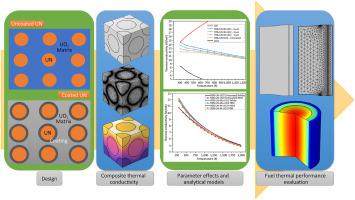当前位置:
X-MOL 学术
›
J. Materiomics
›
论文详情
Our official English website, www.x-mol.net, welcomes your feedback! (Note: you will need to create a separate account there.)
Temperature-dependent thermal conductivity and fuel performance of UN-UO2 and UN-X-UO2 (X=Mo, W) composite nuclear fuels by finite element modeling
Journal of Materiomics ( IF 9.4 ) Pub Date : 2024-03-13 , DOI: 10.1016/j.jmat.2024.02.007 Faris Sweidan , Diogo Ribeiro Costa , Huan Liu , Pär Olsson
Journal of Materiomics ( IF 9.4 ) Pub Date : 2024-03-13 , DOI: 10.1016/j.jmat.2024.02.007 Faris Sweidan , Diogo Ribeiro Costa , Huan Liu , Pär Olsson

|
The temperature-dependent effective thermal conductivity of UN-X-UO (X = Mo, W) nuclear fuel composite was estimated. Following the experimental design, the thermal conductivity was calculated using Finite Element Modeling (FEM), and compared with analytical models for 10%, 30%, 50%, and 70% (in mass) uncoated/coated UN microspheres in a UO matrix. The FEM results show an increase in the fuel thermal conductivity as the mass fraction of the UN microspheres increases from 1.2 to 4.6 times the UO reference at 2,000 K. The results from analytical models agree with the thermal conductivity estimated by FEM. The results also show that Mo and W coatings have similar thermal behaviors, and the coating thickness influences the thermal conductivity of the composite. At higher weight fractions, the thermal conductivity of the fuel composite at room temperature is substantially influenced by the high thermal conductivity coatings approaching that of UN. Thereafter, the thermal conductivity from FEM was used in the fuel thermal performance evaluation during LWR normal operation to calculate the maximum centerline temperature. The results show a significant decrease in the fuel maximum centerline temperature ranging from −94 K for 10% UN to −414 K for 70% (in mass) UN compared to UO under the same operating conditions.
中文翻译:

通过有限元建模研究 UN-UO2 和 UN-X-UO2 (X=Mo, W) 复合核燃料的温度依赖性热导率和燃料性能
估算了 UN-X-UO (X = Mo, W) 核燃料复合材料随温度变化的有效热导率。根据实验设计,使用有限元模型 (FEM) 计算热导率,并与 UO 基质中 10%、30%、50% 和 70%(质量)未涂层/涂层 UN 微球的分析模型进行比较。 FEM 结果显示,在 2,000 K 时,随着 UN 微球的质量分数从 UO 参考值的 1.2 倍增加到 4.6 倍,燃料热导率随之增加。分析模型的结果与 FEM 估计的热导率一致。结果还表明,Mo 和 W 涂层具有相似的热行为,并且涂层厚度影响复合材料的导热率。在较高的重量分数下,燃料复合材料在室温下的导热率很大程度上受到接近 UN 的高导热率涂层的影响。此后,FEM 的热导率用于 LWR 正常运行期间的燃料热性能评估,以计算最大中心线温度。结果显示,与相同操作条件下的 UO 相比,燃料最高中心线温度显着降低,范围从 10% UN 的 -94 K 到 70%(质量)UN 的 -414 K。
更新日期:2024-03-13
中文翻译:

通过有限元建模研究 UN-UO2 和 UN-X-UO2 (X=Mo, W) 复合核燃料的温度依赖性热导率和燃料性能
估算了 UN-X-UO (X = Mo, W) 核燃料复合材料随温度变化的有效热导率。根据实验设计,使用有限元模型 (FEM) 计算热导率,并与 UO 基质中 10%、30%、50% 和 70%(质量)未涂层/涂层 UN 微球的分析模型进行比较。 FEM 结果显示,在 2,000 K 时,随着 UN 微球的质量分数从 UO 参考值的 1.2 倍增加到 4.6 倍,燃料热导率随之增加。分析模型的结果与 FEM 估计的热导率一致。结果还表明,Mo 和 W 涂层具有相似的热行为,并且涂层厚度影响复合材料的导热率。在较高的重量分数下,燃料复合材料在室温下的导热率很大程度上受到接近 UN 的高导热率涂层的影响。此后,FEM 的热导率用于 LWR 正常运行期间的燃料热性能评估,以计算最大中心线温度。结果显示,与相同操作条件下的 UO 相比,燃料最高中心线温度显着降低,范围从 10% UN 的 -94 K 到 70%(质量)UN 的 -414 K。































 京公网安备 11010802027423号
京公网安备 11010802027423号